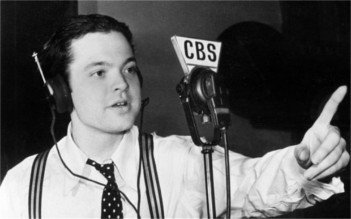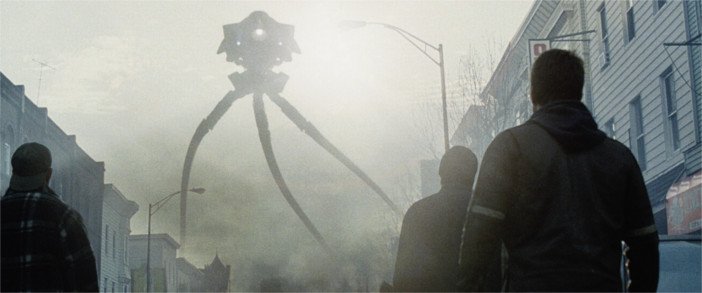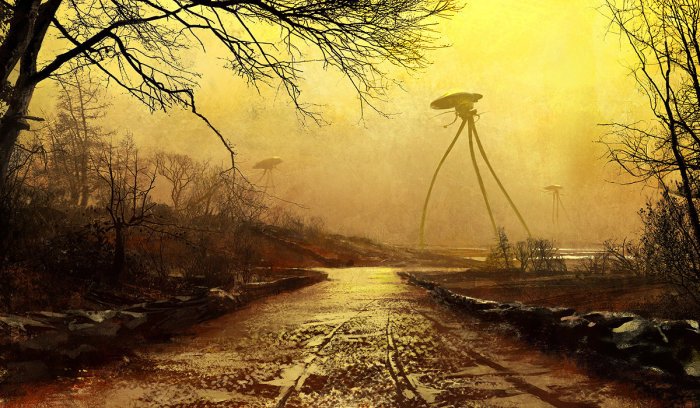Literature on Film | Part 7 | War of the Worlds Never Needed Hollywood to Wow Audiences
The now infamous, although somewhat refuted, panic that swept the radio listeners of 1938 America has become a symbol of the realism and strength of one of the most iconic pieces of science fiction of all time. When Orson Welles et al went over the airwaves, way back when, the source of their adaptation was already forty years old, with the H.G Wells novel coming out in 1898.
Can we just take a moment to appreciate this fact and really let it seep in. Not only will it be vital in my arguments for it as a superior piece of artistry but it still blows my mind every time I recall the point: War of the Worlds came out in 1898.
At the end of the 19th Century, there was not much in the way of popular science fiction. Mary Shelly’s Frankenstein (1818) is arguably the first, post-scientific revolution, seminal piece of science fiction. Throughout the 1800s there were other noteworthy examples such as Alexander Veltman’s Predki Kalimerosa: Aleksandr Filippovich Makedonskii (The forebears of Kalimeros: Alexander, son of Philip of Macedon) which introduced the concept of time travel to the genre and also the poetry of Victor Hugo introduced audiences to dystopian ideas. In the latter decades of that century, two pivotal figures in the science fiction game emerged, Jules Verne and H.G Wells.
It seems that these two split the hardcore science fiction world. Verne, choosing to stick to more realistic science and technology with Wells flourishing in character-driven novels in the midst of science fiction.Personally I can forgive some haphazard science or unexplained technology if it results in a creative and engrossing story.

The 1938 recordings were my first introduction to the original invasion story. The radio series was the first of its kind I had ever heard, and I was confused. The music from the concert hall was playing throughout the first two thirds, of the hour long series, with interluding special announcements of the martian invasion. The musical sections were at times purposefully left playing for extended periods to emphasise the tension.The final third, like the book, concentrates on the aftermath of the invasion and the demise of the invaders.
The radio productions are a treat to listen to. Orson Welles’ performance brought him overnight success and, at the tender age of 23, kick-started his extensive and illustrious Hollywood career. The music is also an integral part of the production. As I previously mentioned, the timing of the music is an equally important driving force of the atmospheric tale as the announcements. The music was provided by Bernard Herrmann and his orchestra. The partnership of Herrmann and Orson would prove to be beneficial for both; Herrmann went on to produce the original score for Citizen Kane, earning him an Academy Award nomination. Herrmann is particularly known for his collaborations with director Alfred Hitchcock, most famously Psycho, North by Northwest, The Man Who Knew Too Much, and Vertigo. He also composed scores for many other movies, including Jason and the Argonauts, The Day the Earth Stood Still, Cape Fear, and Taxi Driver.
It would be several years later before I ventured into the world of H.G Wells again, this time in the medium of cinema. In my early college days I was a huge fan of early Sci-fi and B-Movies and during one of my Amazon bargain bin raids I came across the 1953 version of Wells’ vision; The War of the Worlds.
Now considered a classic of the genre, Bryon Haskin’s adaptation takes place in 1950s California and is a celebration of colour and sound. The special effects are now somewhat lacklustre, but at the time were top of the line. Ray Harryhausen actually shot test footage but they instead went for the design of Al Nozaki’s mantra rays floating above the Californian gorse. This choice is also one of the most discernible differences between the original text and the feature adaptation. Where Wells’ Martians got around in tripod constructions, Haskin favoured hovering ships as opposed to the walkers. H.G Wells didn’t put the Martians in flying machines, which makes sense, as it was published five years before the Wright Brothers took to Kitty Hawk.

While on the topic of Martian machinery, I must say the idea of the walking metallic tripods with deadly heat rays is truly terrifying. The recognisable animalistic motions of the mechanical giants are a perfect juxtaposition of familiar and alien. It was a useful way of adding tension and horror to the tale: I could see the tripods move around in my head, I could hear the heavy metal smash the ground beneath upon each step. This is where I think Haskin stumbled. Perhaps it was a matter of functionality and they were simply unable to make the monstrous machines look as they hoped – choosing floating ominous ships instead. Nozaki did, however, add an animalistic nature to his creations; the mantra ray bodies with cobra-styled, periscope-like, heat rays protruding from the top. The War of the Worlds received the Academy Award for Best Visual Effects that year.
In 2005, Spielberg directed the best known of the feature films adapted from H.G. Wells’ novel and upon my original viewing I was neither blown away nor left wanting. Any real emotion I had towards the movie, came after I finally got around to reading the original.
The book reads as the journal of an unnamed narrator as he frantically tries to figure out what the mysterious cylinders are and then reunite with his wife once the chaos begins. It is told from his point of view and you are taken on a journey of terror, paranoia and utter bedlam. You feel as if you are right there beside him and, although he is telling the story, so we know he survives, we continually fear for his safety. The immersive language used by Wells throughout – describing the wet and muddy conditions of our protagonist’s hideouts, the sense of awe as the power of the Martian’s heat rays is realised and the sheer power and horror of the “Gorgon of tentacles” as they seem to roll across the landscape at tremendous speed – simply blew me away.
Whether Wells is describing the proposed route our narrator must take through forest and village to get to London or the panic at a village crossing as hundreds flee in a melee of man, horse and cart, the atmosphere jumps from each page. You can feel the Black Smoke in the back of your throat, you can hear the cacophony of horrific sound coming from the oncoming tripods, you can feel yourself urging our man to pick up a rock and knock out the Curate when he is breaking down and causing a ruckus. You want him to survive at all costs. You know it’s every man for himself: it’s breathtaking.

It is this survivor aspect of the novel that is lost in Spielberg’s mainstream feature. Now, I understand that having Tom Cruise playing a deadbeat dad putting his life on the line for his kids makes for Hollywood gold, but, that’s not what I want. I also think that even though the book was my last dalliance with the story, albeit the original, it felt the most real to me. It stuck with me and that was the world in which I believed it existed. The movies felt as though someone was cast as one of your favourite literary characters and it just doesn’t sit well in your head.
The science, or science fiction, of War of the Worlds is also something worth noting. Back in 1898, the electron was just discovered and the term radioactive was first coined by Marie Curie. Edwin Hubble was in diapers and it would be sixty years before Sputnik would enter orbit. Wells created a story part science and part science fiction.
Twenty years before Wells put pen to paper Italian Astronomer Giovanni Schiaparelli observed a geographical feature on the red planet which he called canali (channels), this in turn was mistranslated to mean canals and the idea of running water and therefore life on Mars was created. Wells drew upon this to create one of the first invasion stories in the science fiction genre. But how would lifeforms get from one planet to another? Giant space guns of course. Here is where the science fiction comes in and where I have to give Wells the benefit of the doubt. If you can appreciate the scientific knowledge of the time and try to picture giant cannons shooting cylinders (capsules) to hurtle through our solar system and hit Earth, it is not really that crazy. The heat rays possessed by the Martians on the other hand were a piece of science fiction genius. Not only had nothing like it been seen before, but he didn’t have to explain how it worked, it was, after all, alien technology. The unknown is terrifying. Wells, like horror and science fiction writers alike, knew this and capitalised on it.

Fast forward over one hundred years, Spielberg and his screenwriters are trying to figure out how the aliens get from wherever-they-came-from to Earth. A lightning storm of course. What? That’s utter nonsense. Not only is it a ridiculous delivery method but the fact that the machines they embody have been underground since before man, or at least centralised populations, is just unbelievable. Now, I hear you screaming, “it’s science fiction, Paddy, relax”, but come on. If a hundred years of scientific discovery has given you no new insights into how to approach alien technology, you’re just not trying hard enough. Maybe it’s so ridiculous, it’s original? I’m not sure, but it definitely irks me.
The one facet of the original story residing in each of the adaptations is the demise of the invaders. No matter what man throws at the Martians, their resilience is unfathomable but in the end they fall at the hands of the minute bacteria we live with each and every day. This beautifully simple and yet completely out-of-the-blue conclusion stems from Wells’ love of natural sciences. He was a student of Huxley and an avid fan of Darwinism and natural selection. This finale was widely criticised by audiences and critics alike when Spielberg’s feature was released. Well, screw you Hollywood. It’s genius.
If you are a fan of science fiction in any capacity I can’t recommend this novel enough. I was enthralled from beginning to end and unlike the Hollywood adaptations, you will be transported back to a time before Hollywood-produced-heroes and when you got from A to B on a horse.
Featured Image via ftpweb.mazedanetworks.net

